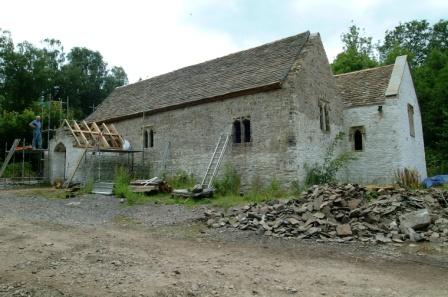St Teilo's Church, The Museum of Welsh Life
Tŷ-Mawr Posted this on 10 Jan 2023
 The Museum of Welsh Life, now the National History Museum at St Fagans, in reconstructing the 13th St Teilos Church chose a ‘modern’ flooring system designed for them by Ty-Mawr Lime Ltd.
The Museum of Welsh Life, now the National History Museum at St Fagans, in reconstructing the 13th St Teilos Church chose a ‘modern’ flooring system designed for them by Ty-Mawr Lime Ltd.
Client: St Fagan's National History Museum
Materials Supplied: Fat lime, Limewash, Limecrete floor.
The church, which is believed to have been built during the 12th century, on the site of an earlier Pre-Norman church, originally stood close to the banks of the river Llwchwr outside Pontarddulais, near Swansea. It was abandoned in 1970 and was eventually offered to the Museum in 1984.
Moved stone by stone to the museum by heritage experts over twenty years and a distance of fifty miles, St Teilo's Church is an impressive project.

The fact that the building was constructed with lime allowed it to be dismantled, moved and reconstructed. It was rebuilt using traditional lime mortars and plasters from Ty-Mawr. With careful planning, a well-defined build programme and on-site support from Ty-Mawr staff, the entire reconstruction used Fat lime.
The decision was made to install heating with the use of a controllable under-floor heating system combined with a limecrete floor fed by a Ground Source Heat Pump.
The insulated limecrete floor was developed by Nigel Gervis of Ty-Mawr Lime Ltd who first used the system in his own Georgian kitchen to replace a flagstone floor bedded on earth (along with the usual cement patch repairs by previous owners!). It was felt that a dense concrete slab was inappropriate as it would interrupt the way in which the building was designed to work. Having undertaken various trials and then the necessary testing on the floor, the floor was launched and Ty-Mawr has now specified and supplied 100s of floors throughout Wales and the UK for domestic, commercial and public buildings.
 Its reconstruction on the museum site takes the church back to 1520 when the interior was brightly decorated with murals, paintings, and carvings.
Its reconstruction on the museum site takes the church back to 1520 when the interior was brightly decorated with murals, paintings, and carvings.
Opened on October 14th, 2007 by the Most Reverend Archbishop of Canterbury, Dr Rowan Williams, the church attracts visitors from all walks of life including those interested in traditional building techniques, visual art and religious and social history.
See the building for yourself, it is well worth the visit! http://www.museumwales.ac.uk/en/stfagans/historic-buildings/
